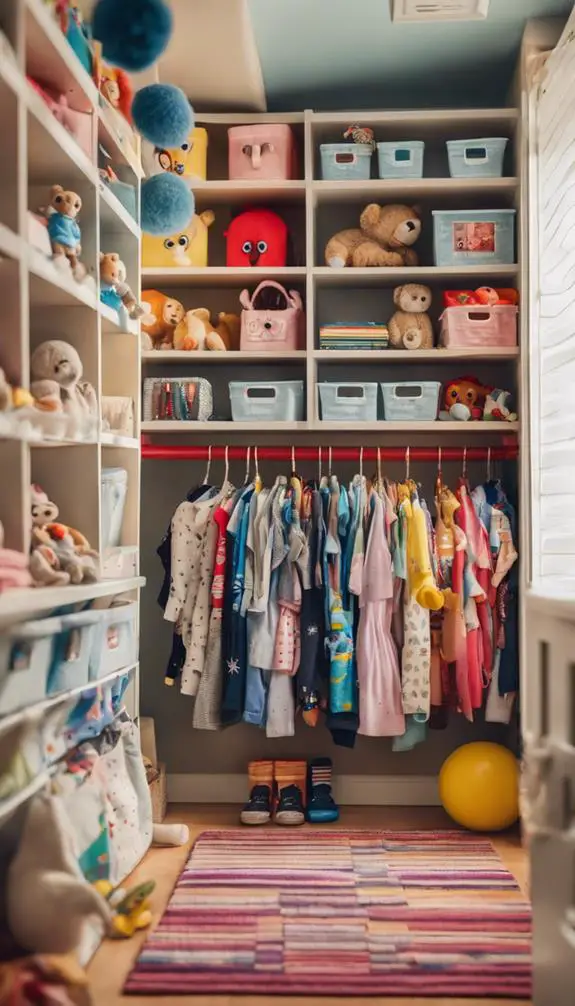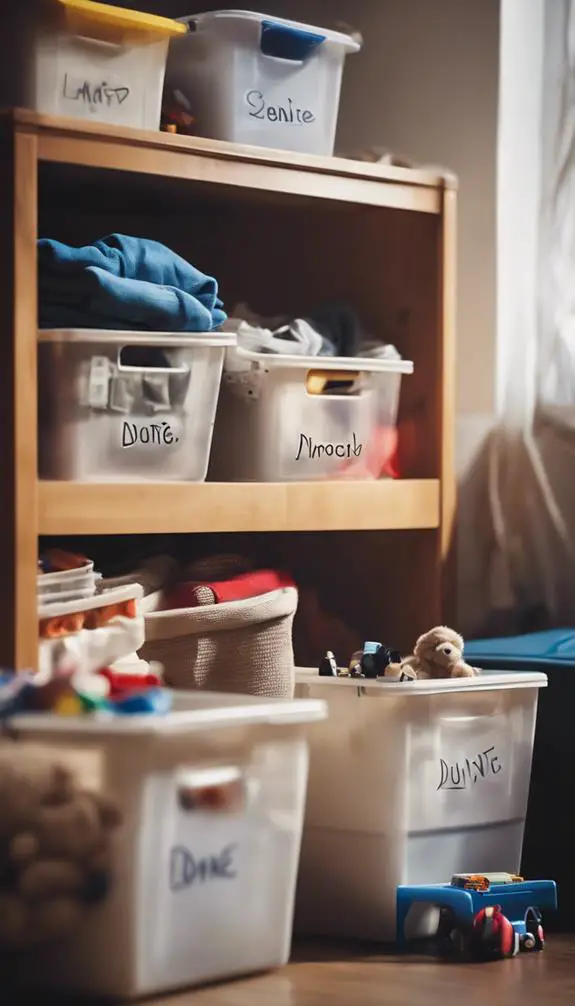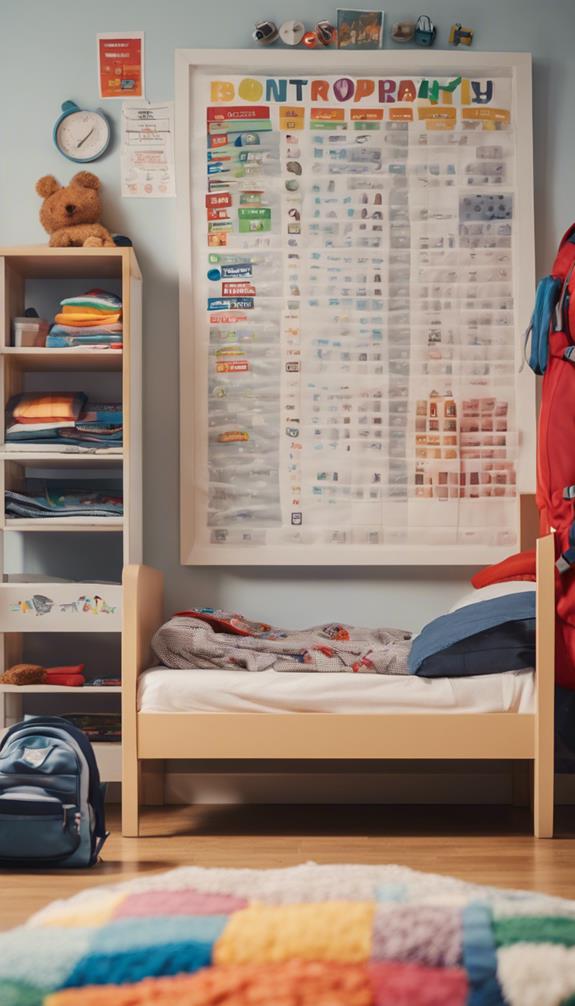As you stand in your child's bedroom, surrounded by toys, clothes, and clutter, you can't help but wonder how they'll ever learn to keep their space organized. The truth is, teaching kids bedroom organization skills takes patience, consistency, and a clear plan. By establishing routines, assigning homes for toys and clothes, and utilizing storage solutions, you can help your child create a peaceful and functional space that promotes responsibility and independence. But where do you start? That's the million-dollar question, and one that we'll explore further – but first, let's take a closer look at the benefits of a well-organized bedroom.
Creating a Bedtime Routine

With a cluttered bedroom, a bedtime routine can easily fall by the wayside, making it challenging to unwind and prepare for a restful night's sleep.
You can take control of your sleep schedule by establishing a consistent bedtime routine. Start by setting a specific bedtime and sticking to it, even on weekends.
Next, incorporate relaxation techniques, such as deep breathing, reading, or listening to calming music, to help your mind and body relax.
Aim to wind down at least 30 minutes before bedtime to signal to your brain that it's time to sleep.
Assigning a Home for Toys

Your bedroom isn't just a place to sleep; it's also a space where your kids can play and express themselves.
Assigning a home for toys is vital to maintaining a tidy room. Create Toy Zones and Play Stations to corral toys and encourage imaginative play.
Designate areas for building, dressing up, and reading to keep toys organized and accessible. Label each zone to help your kids quickly find what they need and put things back in their place.
Designing a Functional Closet

You're about to create a closet that's more than just a space to hang clothes – it's a haven of organization and efficiency.
To start, you'll want to maximize your storage space by using every available inch, from floor to ceiling.
Storage Space Maximization
By incorporating clever design elements, you can tap the full potential of your closet space, transforming it into a haven of organization and efficiency.
Optimizing shelves is key to maximizing storage capacity. Install adjustable shelves that can be tailored to fit different sizes of bins and baskets.
Labeling bins and baskets helps your child quickly identify where items are stored, promoting independence and responsibility.
Consider a shelf divider to separate different types of items, such as clothes, accessories, and toys. This will prevent clutter from building up and make it easier to maintain the space.
Double Rod Benefits
Since a functional closet relies heavily on efficient use of vertical space, incorporating a double rod is a game-changer for maximizing storage capacity.
By doubling your hanging space, you'll be able to store more items without overcrowding the closet. This is especially beneficial for kids who've a variety of clothing items and accessories.
With a double rod, you can optimize rod spacing to accommodate different hanging limits. For example, you can dedicate the top rod to longer items like dresses or coats, and the bottom rod to shorter items like shirts or pants.
This organized approach will make it easier for your kids to find what they need and maintain a clutter-free closet.
Utilizing Under Bed Storage

You can substantially increase your bedroom's storage capacity by utilizing the often-wasted space under your bed.
Consider investing in a bed frame with built-in storage or adding roll-out drawers to maximize this hidden area. By doing so, you'll be able to stash out-of-season clothing, linens, or luggage, keeping them out of the way yet still easily accessible.
Maximizing Hidden Space
Tapping into the often-wasted space beneath your bed can be a game-changer for bedroom organization.
By incorporating hidden shelves and secret compartments, you can create a treasure trove of storage for your kid's belongings. Consider using under-bed storage bins or drawers that can be easily accessed by sliding them out from under the bed.
You can also install a hidden shelf or compartment underneath the bed frame to store items like out-of-season clothing, linens, or toys. This won't only declutter the room but also keep valuable items out of sight, making it an ideal solution for kids who love to keep treasures hidden away.
Bed Frames With Storage
Bed frames with storage take the concept of hidden space to the next level by integrating storage solutions directly into the bed's design.
You can find storage beds with built-in bed drawers, shelves, or cabinets that provide ample space to store clothing, toys, or linens.
These clever designs keep clutter at bay, creating a more organized and peaceful bedroom environment.
By choosing a storage bed, you'll be able to keep your child's belongings within easy reach, teaching them the importance of putting things back in their place.
This innovative approach to bedroom organization helps you make the most of the available space, keeping your child's room tidy and functional.
Roll Out Drawers
A tidy bedroom starts with maximizing every available inch, and the space under your bed is no exception.
You can utilize this often-wasted area with roll-out drawers, providing easy access to stored items. These rolling shelves can be installed on wheels or sliders, allowing your child to effortlessly pull them out and push them back in.
To keep items organized within the drawers, use drawer dividers to separate clothes, toys, or linens. This will keep clutter at bay and make cleaning a breeze.
Managing Clothing and Laundry

Across the floor of your bedroom, cluttered piles of dirty laundry and clean clothes waiting to be put away can quickly accumulate, making the space feel chaotic and overwhelming.
To regain control, consider implementing clothing stations and laundry schedules. Designate a specific area for clean clothes, and use bins or baskets to separate items by type.
Create a laundry schedule to guarantee regular washing and folding. Assign specific days for washing, drying, and putting away clothes. This routine will help maintain a sense of order and make mornings easier.
Setting Up a Homework Station

You'll want to designate a specific workspace for your homework station, free from distractions and clutter, where you can focus on your assignments.
This dedicated area will help you stay organized and productive.
Designate a Workspace
Setting up a dedicated homework station is essential for maintaining bedroom organization.
You'll want to designate a specific area for studying, free from distractions and clutter. Consider converting a corner of the room into a creative corner, complete with a desk, chair, and good lighting.
This will help your child stay focused and avoid procrastination. A well-designed study area can also inspire creativity and motivation, making homework time more enjoyable.
Organize Essential Tools
Organizing essential tools is crucial to creating an effective homework station.
You'll want to categorize tools into groups, such as writing utensils, art supplies, and tech accessories. This will help your child quickly find what they need, reducing stress and increasing productivity.
Designate essential stations within the homework area, like a pencil case or a tray for frequently used items. Consider a desk organizer or a storage bin with labeled compartments to keep supplies tidy.
Organizing Books and Magazines

In the quiet corners of your bedroom, a cluttered collection of books and magazines can quickly accumulate, making it difficult to relax and unwind.
To regain control, start by assigning a dedicated space for your reading materials. Install bookshelves or bookcases to keep your favorite novels and educational books organized and within reach.
For magazines, consider using magazine racks or baskets to keep them tidy and easily accessible. Label each shelf or basket to help you quickly find what you're looking for.
Decluttering and Donating

Your bedroom's cluttered landscape is a breeding ground for stress, and it's time to tackle the elephant in the room: the overwhelming accumulation of items that no longer serve you.
Breaking free from the habit of holding onto everything is crucial and develop healthy kids' habits of letting go.
Set donation goals, like filling a box or bag, to maintain momentum and make the task less intimidating.
Sort items into categories, such as clothes, toys, and books, and be honest with yourself about what you truly need or use.
Creating a Morning Checklist

Once you've cleared the clutter from your bedroom, it's time to focus on creating habits that'll help you maintain your newly organized space.
A morning checklist is a great way to start. It'll help you develop a daily routine and make morning prep a breeze.
Begin by identifying the tasks you need to complete each morning, such as getting dressed, brushing your teeth, and packing your backpack. Write these tasks down and prioritize them based on importance and urgency.
Then, create a schedule that outlines what you need to do and when. Stick to your checklist and schedule, and you'll find that your mornings become more efficient and less chaotic.
With a morning checklist, you'll be on track to having a more organized and productive day.
Making the Most of Shelves

From floor to ceiling, shelves can be a game-changer in maximizing your bedroom's storage capacity.
You can install shelves at different heights to accommodate items of varying sizes. Use shelf dividers to separate items into categories, making it easier to find what you need.
Label each shelf with shelf labels, so you can quickly identify what's stored there. This system helps maintain organization and prevents clutter from building up.
By utilizing vertical space, you'll free up floor space, creating a more open and inviting atmosphere.
With shelves, you can store everything from books and toys to clothing and accessories, keeping your bedroom tidy and organized.
Establishing a Daily Routine

As you've optimized your bedroom's storage with shelves, now it's time to turn your attention to developing habits that'll help maintain this newfound organization.
Establishing a daily routine is key to keeping your bedroom tidy and clutter-free.
Start by creating a morning prep routine that sets you up for success. This might include making your bed, putting away toys and books, and getting dressed.
In the evening, wind down with a routine that signals to your brain that it's time to relax. This could include putting away electronics, tidying up any mess, and prepping for the next day.
Teaching Kids to Fold Clothes

By involving your kids in the process of folding clothes, you'll not only teach them a valuable life skill but also pass on the responsibility of maintaining their own space.
Start with simple folding techniques, like folding towels or washcloths, and gradually move on to more complex items like t-shirts and pants.
Demonstrate different folding styles, such as the KonMari fold or the military fold, and let them choose the one they prefer.
As they master the skills, encourage them to take ownership of their laundry independence.
This won't only save you time but also instill a sense of pride and accomplishment in your kids.
Implementing a Weekly Review

Every Sunday evening, set aside 15-20 minutes to conduct a weekly review with your kids, focusing on their bedroom organization progress.
This review helps reinforce task management skills, ensuring they stay on track and develop healthy habits. During this session, go through their to-do lists and tasks, crossing off completed items and discussing challenges they faced.
Use this opportunity to praise their efforts and identify areas for improvement. By implementing this weekly review, you'll help your kids form good habits, take ownership of their space, and develop a sense of responsibility.
It's a great way to instill discipline and accountability, setting them up for success in the long run.
Frequently Asked Questions
Can I Use a Storage Ottoman as a Seat and Storage?
You can totally use a storage ottoman as a seat and storage – just choose an ottoman that fits your needs, considering sizes like cube or rectangle, and materials like sturdy fabric or durable wood, to maximize functionality and comfort.
How Do I Keep My Kid's Desk Organized During Homework Time?
To maintain a clutter-free workspace during homework time, you'll want to create a study station with desk dividers that separate tasks, keeping essential supplies within reach and encouraging focus.
Are Stackable Bins Better Than Hanging Organizers for Clothes?
When deciding between stackable bins and hanging organizers for clothes, you'll find stackable bins offer benefits like easy access and visibility, perfect for storing folded clothes, while hanging organizers are better suited for items that are best kept on a hanger.
Can I Use Adhesive Hooks to Hang Backpacks and Jackets?
You can use adhesive hooks to hang backpacks and jackets, considering hook placement to avoid crowded areas. If you're concerned about damage, explore hook alternatives like 3M command strips or over-the-door hooks for a damage-free hold.
How Often Should I Rotate Toys to Keep Them Interesting?
You should rotate toys every 2-3 months for a toy refresh, implementing play rotation to keep them interesting and preventing boredom; this encourages imagination, exploration, and a sense of novelty, sparking creativity and excitement in little minds.
Conclusion
You've created a bedroom organization system that works for your kids. Now, crucially, maintain it. Stick to your bedtime routine, and encourage your kids to put away toys and clothes after playtime. Regularly review their spaces, and make adjustments as needed. By doing so, you'll help your kids develop good habits, a sense of responsibility, and independence. With time, they'll learn to appreciate the value of a clutter-free space and the importance of giving back.




